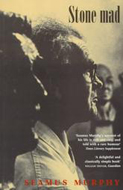Book Review: Stone Mad - May/Juner 2008
- Details
- Created: Friday, 02 May 2008 06:20
Written in 1950, Stone Mad was first published in hardback in 1966 and in paperback in 1977 and 1982 by Routledge and Kegan Paul Limited. My copy is a 1997 paperback issue from Blackstaff Press Limited and is a photolithographic facsimile of the first edition. Illustrations are by William Harrington.
Seamus Murphy lived from 1907 to 1975. His personal story is not quite like the men you will read about in his book. While most of them remained tied to their bankers in production shops, typical of carvers at the time, Seamus Murphy managed to escape to something different. His studies of clay sculpting classes while working as an apprentice and his natural abilities resulted in him opening his own shop. His unique style, a departure from the standard Celtic motif, and his fine, artistic touch was much sought after, providing him a comfortable living.
Stone Mad by Seamus Murphy is a dandy read. The novel’s 226 pages are brimming with Seamus’ stories based on his early apprenticeship and subsequent career in the stone carving trade of County Cork, Ireland. The memorable and loquacious characters he brings to life, speak to us with a rolling good humor and a fetching Irish lilt. From their sweat shop bankers in the rustic carving sheds of the early 20th century, these men regale us with charming tales, heated arguments and shameless lies about their work on construction jobs for everything from cathedrals to tombstones.
The book came to NWSSA through Keith Philips when a friend of his from Ireland gave him a copy. Keith can usually be found carving in his shed at Marenakos’ Tenino sandstone quarry using many of the old methods and tools described in the book. He tells the story of coming across a penny-faced Hammer in a used tool store. He had read about the penny-face in Stone Mad, with each of its two faces the exact size of an English penny. Some of Seamus’ characters revered the penny-face for its supposed mystical qualities, and one can easily believe that Keith subscribes to the same reverence. Creating characters with nick-names like Blueskull, Stun, Blackjack and the Gargoyle, Seamus paints a clear and inevitable picture of how the carving sheds began to thin out with the advent of concrete.
After several of the older men get their pink slips so the new boss can hire fewer, younger, cheaper carvers the old hands are talking about how the trade is nearly finished, when the clean up boy adds his two cents worth: ‘I told you that years ago,’ said Danny.’ ‘And you wouldn’t believe me. The pre-cast concrete is going to wipe it out – door-blocks, sills, window – heads, jambs – they can turn anything out of it, an’ it does the job as well. People don’t know the difference and, anyway, they haven’t time to be thinking of that sort of thing. It’s just slap it up and get it finished.’
The character of Danny Melt was used by Seamus to give voice to many of the arguments at the bankers in the carving shed. Here’s Danny berating the men for what he thought of as a too keen interest in their work. ‘I’ll tell you what’s wrong,’ said Danny. ‘I’m fed up with all this talk about the craft. Wan would think there was nothing else in the world. Mornin’, noon an’ night, ye’re at it. No wonder people say ye’re stone mad. Sunday or Monday, ‘tis all the same to ye. D’ye get a wink of sleep at all for thinking of it?’
I’ll wager some of us have heard the same sort of thing from people who think we go on a little too much about the wonders of our own stone carving.
Stone Mad is a good read for carvers because it talks so much about the elements of the trade, but it is also a great find for those looking for a well written book about another time and another place.
Many on-line book sellers and stores such as Borders carry Stone Mad. Find yourself a copy and have a wonderful read.

 sculpture overlooks Useless Bay and is of special significance for its new owners. Bernie tells us that from the time he first saw it in Lloyd's studio yard, the stone's configuration suggested to him a meditative state invoking the innate balance of the male and female principle. Appearing to float in the Camin's perfectly placed yard, the stone's strength, yet fragile shape seem to make a perfect portal through which to view the world.
sculpture overlooks Useless Bay and is of special significance for its new owners. Bernie tells us that from the time he first saw it in Lloyd's studio yard, the stone's configuration suggested to him a meditative state invoking the innate balance of the male and female principle. Appearing to float in the Camin's perfectly placed yard, the stone's strength, yet fragile shape seem to make a perfect portal through which to view the world.